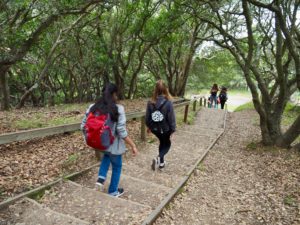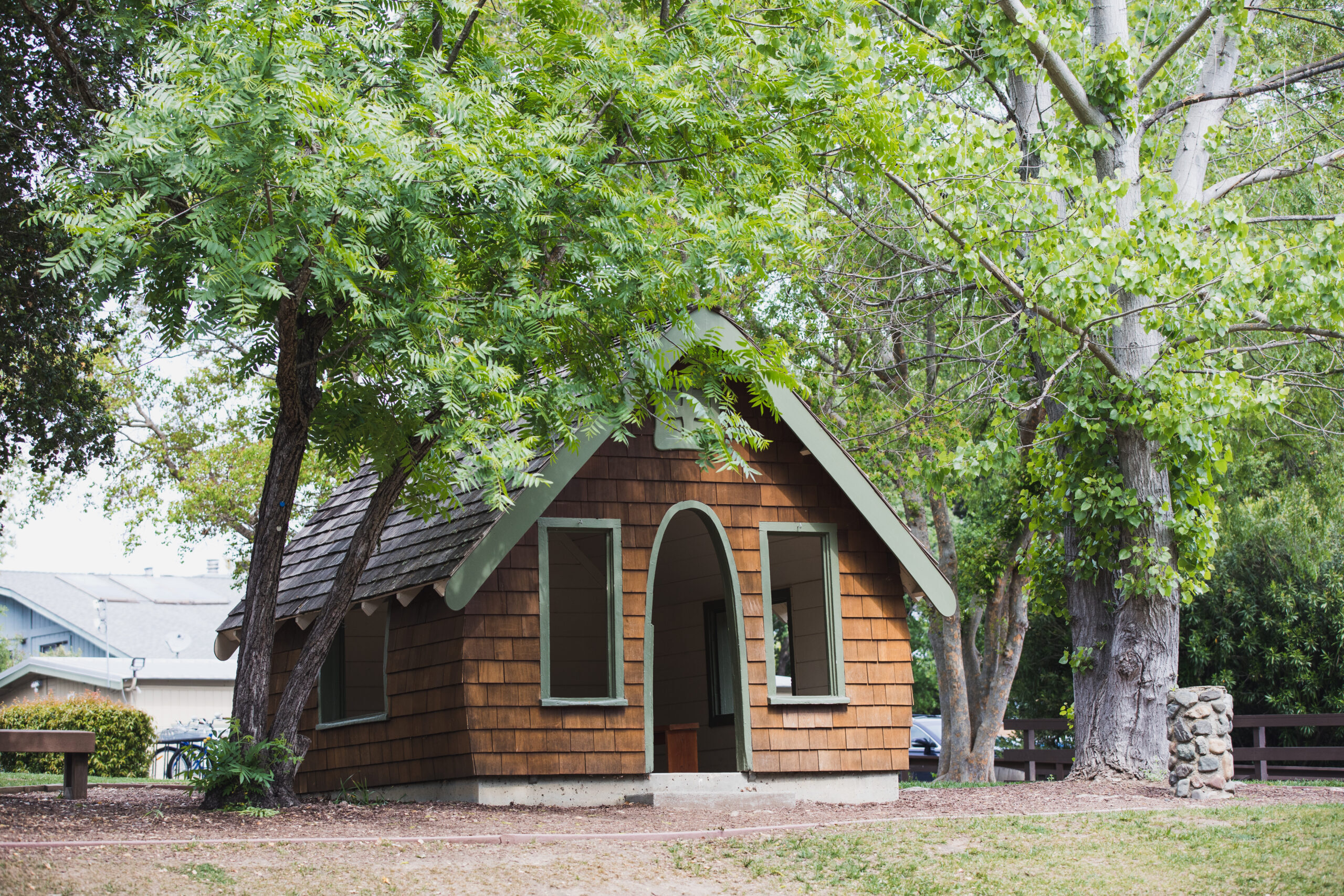
Hillbrook launched our first-ever Reach Beyond Week April 2-6. During the week, the entire 6th-8th grade participated in a broad range of real-world learning experiences that extended beyond the campus and challenged students to think about how they could make a difference in the world. The week was an opportunity to design and implement the type of integrated, project-based, hands-on learning we are increasingly trying to provide as a school for all of our students from grades JK-8.
So what did we learn?
“What matters to you?” is a powerful question
Throughout the week, students had an opportunity to ask different people the same question, “What matters to you?” The answers and the conversations provided a powerful gateway for students to understand how they can reach beyond themselves to make a difference in the world.
So what did people say?
“Being kind,” responded Mallory, a sales representative at the Patagonia store in Ventura.
“Leave no trace and be a force for good” offered Mallory’s colleague, Kyle.
“Happiness,” shared Michelle, the store owner at the Refill Shop in Ventura, a small cosmetics company that uses reusable bottles and containers to mitigate waste.
Hearing from different people, students were challenged to contemplate what their own answer to the question would be. What a gift as an adolescent to be given the time and space to think about what matters to them at this moment, and to develop the confidence to name it for themselves and peers.
In addition, it reaffirmed the core values that we instill in our students each day at Hillbrook. It was a powerful reminder to me: the values you learn as a child – and the ability to name them for yourselves and others – provides you the confidence and clarity you need to make a difference in the world.
Student choice makes a difference
It may have been the most powerful moment of the week for me. Our group was sitting in a circle in the midst of Poco Farm, a small regenerative learning farm in Ojai. The farm’s owner was beginning to talk to the students about sustainable clothing and the fibershed, helping them understand how they could play a role in minimizing the impact of clothing on the environment. She talked about the toxicity of the dyes used to make many of the bright colors we see in our clothing, and shared about the amount of plastic found in nearly every item of clothing. How might you minimize your impact on the environment, she asked?
What followed was a 10 minute idea storm from the students that left me (and, I think her) somewhat stunned. The students knew a lot – they rattled off multiple ways they were minimizing their impact on the environment, from sewing their own clothes, to piecing together new clothing from different materials, to repurposing clothing they had outgrown (taking a young child’s dress and turning it into a shirt as they grew older, for example). They generated more ideas than she had even considered, and she quickly recognized that this was not your typical group of students.
I have participated in many field trips in my time, and what I realized at that moment was that this was different. On every other field trip, at least a few students are disengaged, as they are being asked to participate in something that doesn’t really interest them. On this trip, there was not a single student in the group who felt disengaged or bored. Each of these students had chosen this trip. This was their passion.
All too often, students are forced to endure school so they can get to something that they care about. Reach Beyond Week reaffirmed what we know – student choice leads to authentic engagement.
Discovering problems is important work
As a society, we often focus on finding solutions. Less often do we emphasize the need to discover and deeply understand a problem. Yet, without a true understanding of a problem, we run the risk of creating solutions that don’t work.
Reach Beyond Week created ample opportunity for students to discover problems. I had the privilege on Friday of seeing a series of presentations by students from two different groups, and I was struck by the number of problems they had identified during the week. Among the problems were:
- The woeful underutilization of public transportation in San Jose. Less than 1 percent of San Jose residents use public transportation.
- The excessive waste created by water bottles. Some estimate that 75 percent of water bottles end up in the garbage.
- The persistence of homelessness in San Jose. There are, according to homeless advocates, 7,000 homeless people in San Jose today.
- The need to find a use for the scraps created during the creation of clothing.
- The waste created by used clothing.
- The lack of basketball courts in downtown San Jose for community usage.
The students then offered a number of creative solutions to these problems – refill stations to minimize bottle usage, bedding filled with used fabric scraps, tiny houses to meet temporary housing needs for homeless people, sites in current parks where basketball hoops could be built. The solutions were thoughtful and had a great deal of potential, and, of course, implementing them is complex.
And yet the point was not to have students quickly solve problems that have bedeviled our society for years. The point is to raise awareness and to create an opportunity for students to apprentice a problem alongside experts who have devoted their careers and personal energy to this work. These experiences equip our students with the confidence, knowledge, and skills they need to be the change makers of tomorrow. And, in the process, if they decide to take action, all the better.
Just ask the Director of the Scott Center for Social Entrepreneurship Annie Makela. She returned to her office this week to discover the following email:
Hi Ms. Mak,
Hope your break went well! I am starting a fashion business and think that you could really help me with some next steps. Would you mind/be available to meet sometime soon? 4th period on b-days work well for me, or after school. Thanks!
Initiative, passion, confidence. Our students are clearly developing the skills that they need to reach their highest potential in school and in life.
Space & Place Matter
Reach Beyond Week introduced students to an extraordinarily diverse array of learning spaces. China, Southern California, San Francisco, Oakland, Salinas Valley, and East San Jose were just some of the locations students traveled. In the process, they extended their learning off campus and redefined what a classroom can be. Students also engaged with a diverse group of people, and had opportunities to learn with and from them about all types of topics and experiences.
Some of the most powerful learning was life learning – how to ride public transportation, how to behave in a co-working space like WeWork, how to get on and off an elevator in public, how to interview people about their jobs and about their interests in different types of work environments, how to order food and manage money in a large urban market like Grand Central Market in LA or San Pedro Square in San Jose, how to act around a 6-day-old goat.
Moving outside the traditional walls of the classroom also creates meaningful opportunities for students to immerse themselves in the incredible diversity of Silicon Valley and beyond. As a school, we are committed to being an intentionally diverse community. Experiences like Reach Beyond Week greatly expand the opportunities for students to engage with different people and cultures in ways that extend beyond the typical classroom interactions.
On the final day, I was talking to one of our students about WeWork, a space that we have increasingly been using to support our reach beyond efforts. He described how the environment felt different from school, and shared that he felt like it encouraged him to work in a way that was more adult and professional. “We should come here more often,” he noted.
As we have increasingly shown as a school, the best learning spaces are flexible and allow students and teachers to co-create them in order to best support the learning experience happening at that moment. Reaching beyond our campus opens up a whole new set of spaces that can be utilized at different times and for different reasons. Ultimately, we should be finding spaces that support a wide-range of student learning and we should be encouraging our teachers and our students to use spaces that fit the learning goals they have.
So….what’s next?
As I noted in the beginning, Reach Beyond Week was just the beginning. We will be implementing a new schedule next year that will increase our ability to extend learning beyond the campus for all students, from grades JK-8, and that will support our efforts to develop more integrated, project-based learning experiences. The learning from this year’s Reach Beyond Week will be invaluable as we try to think about how to shape more of these experiences for children of all ages.
